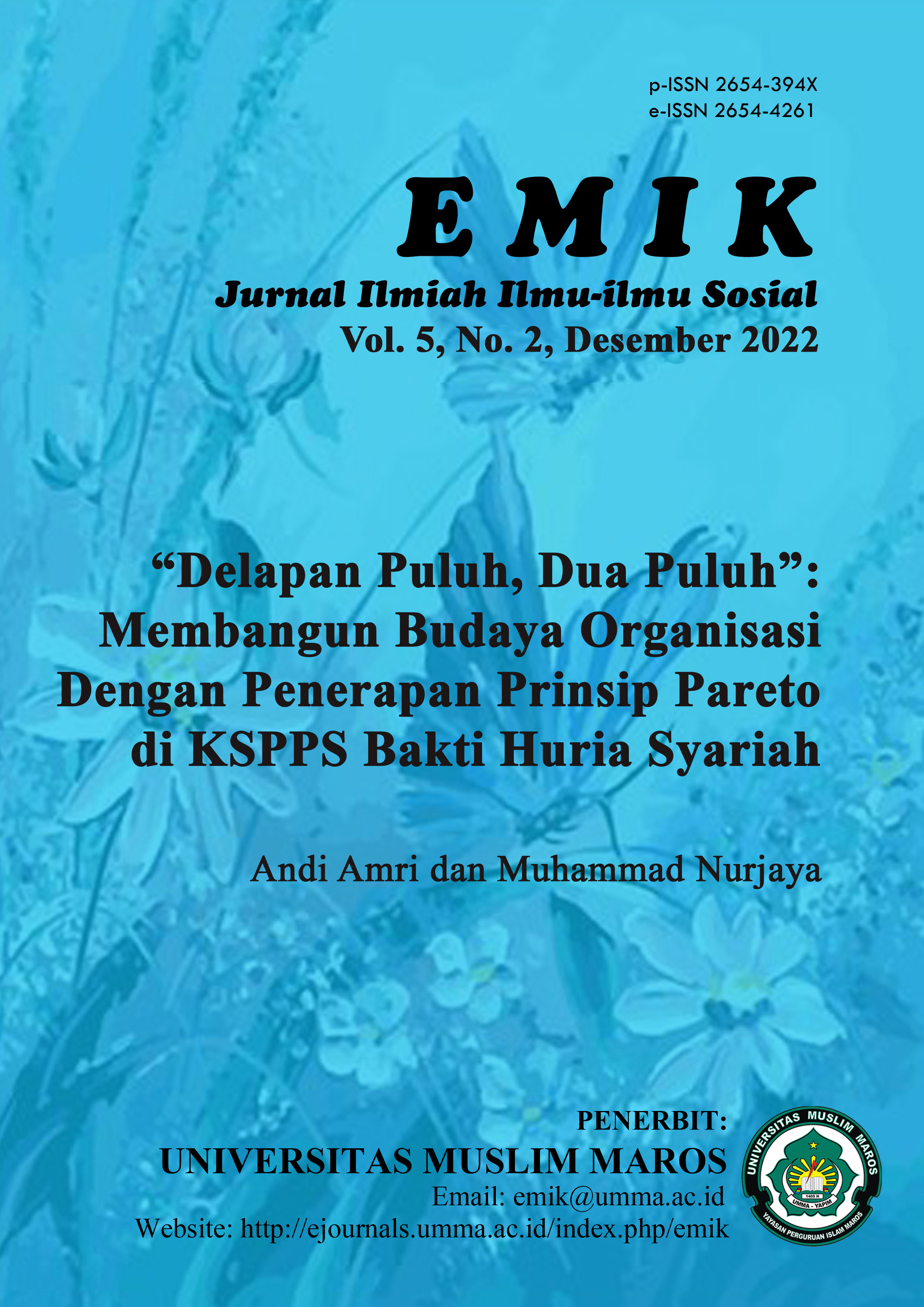“Delapan Puluh, Dua Puluh”: Membangun Budaya Organisasi Dengan Penerapan Prinsip Pareto di KSPPS Bakti Huria Syariah
DOI:
https://doi.org/10.46918/emik.v5i2.1601Keywords:
Pareto Principle, Organizational Culture, Cooperative, Planning, Evaluation and EvaluationAbstract
The 80/20 principle initiated by Vilfredo Federico Damaso Pareto and known as the Pareto Principle. It is a principle in the business world where 20% input will produce 80% output. While a number of literatures shows that there is a significant influence between organizational culture and employee performance, this article focuses on the application of the Pareto Principle in KSPPS Bakti Huria Syariah.
This qualitative research was carried out at the KSPPS Bakti Huria Syariah in South Sulawesi Province with two case studies, namely the KSPPS Bakti Huria Syariah Makassar Branch and Maros Branch. While the former represents a branch with many problematic partners/members, the latteris a branch who successfully apply the Pareto Principle. Data was collected using interview and observation. Interviews were conducted with 25 Heads of KSPPS Bakti Huria Syariah Branch and four managers of KSPPS Bakti Huria Syariah Cnetral Office.
The study indicates that KSPPS Bakti Huria Syariah has four pillars in the welfare of its members, namely spiritual, economic, educational, and social entrepreneurship which is framed in the Vision "Serving One Million Members in 2030 by Using Technology and Working Together with Partners to Touch the Untouchables. Pareto Principle is applied in building a healthy corporate culture by improving governance, especially in business processes, and increasing productivity. he benefits not only experienced by the cooperatives itself, but also by employees and members/partners with various "surprises" provided by the company. But the Pareto Principle is only directed to focus on certain aspects, so comprehensive improvements cannot be carried out simultaneously. It is argued in this article that the Pareto Principle greatly determines the effectiveness of branch work which consists of improving work planning and evaluation, as well as determining the priority scale that has the most influential on the operational performance activities.
References
Ariyanto, M.T. 2021. Mengenal Prinsip Pareto dan Kegunaannya untuk Meningkatkan Efisiensi Dalam Bekerja, https://www.djkn.kemenkeu.go.id/kpknl-bukittinggi/baca-artikel/14487/Mengenal-Prinsip-Pareto-dan-Kegunaannya-untuk-Meningkatkan-Efisiensi-dalam-Bekerja.html, diakses tanggal 12 Oktober 2022.
Dunggio, S. 2020. “Pengaruh Budaya Organisasi Terhadap Kinerja Pegawai Di Kantor Camat Dungingi Kota Gorontalo”, Publik: Jurnal Manajemen Sumber Daya Manusia dan Pelayanan Publik, 7(1):1-9, https://stia-binataruna.e-journal.id/PUBLIK/article/view/114/98, diakses tanggal 15 Agustus 2022.
Erfiansyah dan Herliningsih. 2018. “Analisis Pareto Sediaan Solid Flu dan Batuk di Salah Satu Apotek di Kuningan”, Jurnal Farmasi Muhammadiyah Kuningan, 3(2):17–23, http://ojs.stikes-muhammadiyahku.ac.id/index.php/jurnalfarmaku/article/view/60, 10 Oktober 2022.
Harvey, H. B. dan Sotardi, S. T. 2018. “The Pareto Principle”, Journal of the American College of Radiology, 15(6): 931-943.
Juran, J. M. dan Godfrey, A. B. 1999. Juran’s Quality Handbook. New York: McGraw-Hill.
Kreitner, R. & A. Kinicki. 1995. Organizational Behavior (Edisi Ketiga). Homewood, Illinois: Richard D. Irwin, Inc.
Koch, R. 1999. The 80/20 Principle, the Secret of Achieving More with Less (Edisi Kedua). London: Nicholas Brealey Publishing.
Lako, A. 2002. “Budaya Organisasi dan Kesuksesan Kinerja Ekonomi”, Kajian Bisnis, 27:55-67, https://www.researchgate.net/profile/Andreas-Lako/publication/330872106_BUDAYA_ORGANISASI_DAN_KESUKSESAN_KINERJA_EKONOMI/links/5c590d06299bf12be3fcff66/BUDAYA-ORGANISASI-DAN-KESUKSESAN-KINERJA-EKONOMI.pdf, diakses tanggal 27 September 2022.
Melati; Rahayu, S.; dan Choiriyah. 2022. “Pengaruh Budaya Organisasi dan Motivasi dengan Kedisiplinan sebagai Variabel Intervening terhadap Kinerja Pegawai pada Dinas Pemerintahan Kota Palembang”, Jurnal Nasional Manajemen Pemasaran & SDM, Maret, 3(1):26-38.
Munandar, W.A.; Samsudin, A.; dan Komariah, K. 2020. “Penerapan Budaya Organisasi terhadap Peningkatan Kinerja Karyawan: Studi pada CV. Desain & Bangunan Sukabumi”, Ekuitas: Jurnal Pendidikan Ekonomi, 8(1):28-36, https://ejournal.undiksha.ac.id/index.php/EKU, diakses tanggal 8 Agustus 2022.
Ndraha, T. 2004. Budaya Organisasi. PT. Rineka Cipta: Jakarta.
Mondy, R.W. dan Noe, R.M. 1996. Human Resource Management (Edisi VI). Englewood Cliffs, New Jersey: Prentice Hall.
Pawitan, G. dan Paramasatya, A. 2008. “Aplikasi Analisis Pareto Dalam Pengendalian Inventori Bahan Baku Pada Bisnis Restoran”, Jurnal Administrasi Bisnis, 4(1): 80–96.
Rijanto, A. dan Mukaram. 2018. “Pengaruh Budaya Organisasi Terhadap Kinerja Karyawan: Studi di Divisi Account Executive PT Agrodana Futures”, Jurnal Riset Bisnis dan Investasi, 4(2): 35-47, https://media.neliti.com/media/publications/281684-pengaruh-budaya-organisasi-terhadap-kine-057d6834.pdf, diakses tanggal 1 Agustus 2022.
Saori, S.; Anjelita, S.; Melati, R.; Nuralamsyah, M.; Djorgi, E.R.S.; dan Ulhaq, A. 2021. “Analisis Pengendalian Mutu Pada Industri Lilin: Studi Kasus Pada PD. Ikram Nusa Persada Kota Sukabumi”, JIP: Jurnal Inovasi Penelitian, 1(10):2133-2138, https://stp-mataram.e-journal.id/JIP/article/view/415/346, diakses tanggal 15 Oktober 2022.
Shailer, G. 2004. Introduction to Corporate Governance in Australia. Melbourne: Pearson Education Australia.
Siswanto, E. 2020. “Software Eddy Pareto Mempermudah Peserta Dalam Menganalisis Data Pada Pelatihan Epidemiologis”, Jurnal Masyarakat Mandiri, 4(3):360-369, http://journal.ummat.ac.id/index.php/jmm, diakses tanggal 10 Oktober 2022.
Smircich, L. 1983. “Concept of Culture and Organizational Analysis”, JSTOR: the Administrative Science Quarterly, September, 28(3):339-358, https://www.jstor.org/stable/2392246, diakses tanggal 28 September 2022.
Sofiana, A. dan Sanggala, E. 2021. “Meminimalisirkan Gagal Antar di Kantor Pos Mojokerto dengan Metode DMAIC”, Jurnal Media Teknik dan Industri, 5(1): 1-8, https://jurnal.unsur.ac.id/jmtsi/article/view/1209, diakses tanggal 10 Oktober 2022.
Sunarto dan Santoso W.N. H. 2020. Buku Saku Analisis Pareto. Surabaya: Prodi Kebidanan Mageta, Politeknik Kemenkes.
Susilo, E. 2017. Analisis Pembiayaan dan Resiko Perbankan Syari'ah. Yogyakarta: Pustaka Pelajar.
Taurusyanti, D. dan Kurniadewi, A.O. 2012. “Penggunaan Diagram Pareto, Diagram Sebab Akibat, dan Metode SQC Sebagai Alat Bantu untuk Mengevaluasi Kinerja Produksi Terhadap Tingkat Mutu Produk yang Dihasilkan pada PT. Keramika Indonesia Assosiasi”, JIMFE: Jurnal Ilmiah Manajemen Fakultas Ekonomi, 4(1), https://journal.unpak.ac.id/index.php/jimfe/article/view/587/493, diakses tanggal 10 Oktober 2022.
Tosepu, Y. 2018. Hukum Pareto: Formula 80/20 Yang Dapat Diterapkan Dalam Seluruh Sendi Kehidupan, https://issuu.com/yusrintosepugo/docs/hukum_paret o_yang_dapat_diterapkan, diakses tanggal 26 Mei 2022.
Wahyudi. 2021. Budaya Organisasi: Sudut Pandang Teoretis Dalam Membangun Nilai-Nilai Kerja. Bekasi: PT Dewangga Energi Internasional.










9.png)















